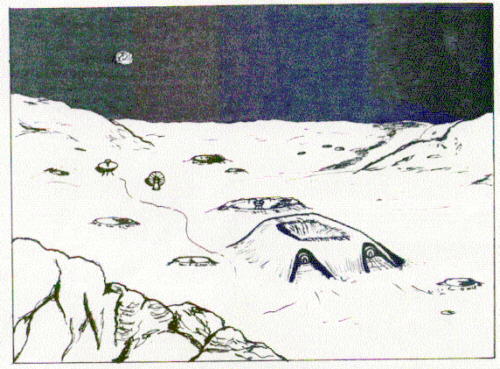|
astrotectonics:
an overview of non-terrestrial construction
By: Thomas M. Ciesla
page 4 of 5
Planetary Facililty Construction
The establishment of early outposts on the Moon and Mars for research and colonization will rely on the use of Spacestation-like habitat and laboratory modules (Luke, M. et.al. 1985). Colonies assembled from these modules satisfy three key problems faced in established early outposts: (1) rapid development and burial necessitated by radiation hazards on the surface of the Moon and Mars (Adams, J.H. 1985); (2) the confidence instilled by using proven technology; (3) cost savings of avoiding additional technology development for these habitats.
As these outposts increase in size and mature in function, emphasis will shift from Earth-fabricated environments to in-situ built structures using local raw materials (Hoffman, S.J. and Niehoff, J.C. 1985; Land, P. 1985; Lin, T.D. 1985). Unique to planetary bases is the coexistence of conditions found in free space along with the constraints found on the surface of an Earth-like bod. The hard vacuum of space exists on the sruface of the Moon, along with the associated temperature extremes. Mars possesses an atmosphere too thin to stablilize day/night temperature variations, but is dense enough to support high velocity winds capable of producing global dust storms.
Also unique to planetary conditions are gravity and day/night or seasonal cycles. The presence of 1/6 Earth gravity on the Moon and 1/3 Earth gravity on Mars precludes the large spider-like trusswork structures of orbital facilities, replaced insteas by terrestrial-like structural systems. Revolution about the Earth produces day/night cycles on the Moon of 14 Earth days each, necessitating the use of nuclear generated power and the development of poerating techniques and procedures for this extended 'night'. The rotation of Mars produces day/night cycles similar to Earth, but the revolution of Mars produces climactic changes responsible for the global dust storms mentioned earlier, which will dramatically affect surface activities and resupply.

Figure 5. Typical Planetary Facility Buried For Radiation Protection
Support Equipment
Construction requirements for planetary bases include the building of protective structures, establishment of ground transportation systems, erection of power generation facilities, and the deployment of scientific experiments. The development of heavy equipment for non-terrestrial construction is paramount to the success of man's efforts to colonize other worlds (Podnieks, F.R. and Roepke, W.W. 1985; Crockford, W.W. 1986). Excavation and earthmoving requirements of habitat burial under several meters of regolith (soil) will be fulfilled by bulldozers and compactors. Cranes wil be necessary to off-load modules and equipment from the landers, while trailers atached to these cranes are necessary to haul this equipment.
Rock melters, which have been proposed for use in establishing in-situ colonies (Bova, B. 1987; Rowley, J.C. and Neudecker, J.W. 1985) may find use in exploratory drilling for scientific experiments, but will more likely become operational during later base expansion, as will fully robotic excavators.
The harsh conditions on the surface of other planetary bodies, forcing man to burrow under the surface for safety, also puts demands on the equipment he will use there. Each machine will be quippped with a self-contained life support system to provide a shirt-sleeve environment for the operator. In addition, the operators's module must have shieding to ffer operator protection from the radiation environment. If the 5REM/year exposure limit for Earth-bases radiation workers is adopted for the colonies, regular working hours will be restricted. However, it will only be after these colonies have grown toa sufficient size (Kolle, H.H. 1986; Dalton, C. and Degelman, L.O. 1972 1972), that surface activity restrictions will bear a marked impact on project programmin, though the need for manufacturing operations inproducing local building materials (Young, J.F. 1985; Khalili, E.N. 1985; Blacic, J.D. 1985), may coincide with the use of robotic mining machines. The use of robotic miners would dramatically reduce the need for men to be involved in the mining and processing operations that would require more and more surface time.
|